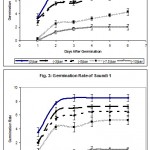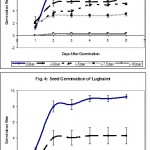How to Cite | Publication History | PlumX Article Matrix
Tahar Boutraa*, Abdellah Akhkha, Abdul Khaliq Al-shoaibi, Owdah Al-Sobhi and Ali Alhejeli
Department Of Biology, Faculty Of Science, University Of Taibah, Almadinah Almunawarah, (Kingdom Of Saudi Arabia).
ABSTRACT: Water stress can greatly reduce crop plants growth in all stages including seed germination, especially in arid and semi-arid regions such as Saudi Arabia which is the driest country in the world. In order to study the effect of water stress on seed germination of different Saudi Arabian wheat cultivars, an experiment was set up to evaluate the effect of a range of water stress treatments (0, -3, -5, -7.5 and -10 bar) on seed germination of four Saudi wheat cultivars (Soundi 1, Soundi 2, Hab Ahmar and Lughaimi). The different water stress treatments were generated using Polyethylene Glycol (PEG). The results showed that the responses of the cultivars to the different treatments were significantly different which indicates that some cultivars were more tolerant of water stress than others. We can conclude that cv. Hab Ahmar was more tolerant under extreme (-10 bar) water stress, whereas cvs. Soundi 2 and Lughaimi were less tolerant. The cultivar Soundi 1 was the most tolerant under -7.5 bar treatment. Recommendations of which wheat cultivar should be used in Saudi Arabian dry conditions will be discussed.
KEYWORDS: water stress; wheat; polyethylene glycol; germination
Download this article as:| Copy the following to cite this article: Boutraa. T, Akhkha. A, Al-shoaibi. A. K, Al-Sobhi. O, Alhejeli. A. Effect of Osmotic Stress Induced by Polyethylene Glycol (PEG) on Seed Germination of Some Saudi Wheat Cultivars. Biosci Biotechnol Res Asia 2009;6(2) |
| Copy the following to cite this URL: Boutraa. T, Akhkha. A, Al-shoaibi. A. K, Al-Sobhi. O, Alhejeli. A. Effect of Osmotic Stress Induced by Polyethylene Glycol (PEG) on Seed Germination of Some Saudi Wheat Cultivars. Biosci Biotechnol Res Asia 2009;6(2). Available from: https://www.biotech-asia.org/?p=8655 |
Introduction:
Drought is the most important environmental stress in agriculture, and it is the major factor in plant growth and plant production [1]. Water stress continues to be one of the most significant abiotic factor affecting growth, development and yield of agriculturally important crops [2]. Drought is a complex physical-chemical process, in which many biological micro- and macro-molecules are involved. Understanding the effect of water stress on growth and yield performance becomes an essential element for planning suitable irrigation systems for wheat [3]. Water stress can affect wheat growth at all stages of development, from germination till seed filling. Plants react differently to water stress depending on growth stage the water stress occurs. A number of researchers reported that drought is related to a range of stresses; such as salt stress, cold stress, high temperature stress, biotic stresses, etc… [4].
Wheat is the main food for more than 35% of the world population. Wheat production is affected by water drought in 50% of the area under production in the developing countries and 70% in the developed countries [5]. As water resources declined in the coming decades [6], due to the global climate change, wheat production will be increasingly affected by water shortage. There has been considerable work in stress-tolerant wheat improvement using classical breeding. Progress for the development of tolerant cultivars faces some difficulties due to the low heritability of this trait and high cultivar x environment interaction in the selection process [7].
Germination is one of the most critical stages of the plant cycle. Seed germination is a pre-requisite for vigour plant growth and development, and it is a major problem of wheat production, especially under water stress conditions [8]. The availability of soil water moisture has a major impact on wheat seeds germination. The reduction in germination rate results in reduced seedling growth and subsequently final plant production.
The aims of the present study are to compare the responses of germination of four wheat cultivars, grown in different regions in the Kingdom of Saudi Arabia, to water stress induced by Polyethylene glycol (PEG).
Materials and Methods
Germination assay
The experiment was conducted in laboratories of Department of Biology, Faculty of Sciences at Taibah University in Al-Madinah Al-Munawarah, Kingdom of Saudi Arabia. Seeds of four wheat cultivars (Triticum aestivum) were collected from different regions for this experiment. The cultivars are (1) Hab Ahmar, (2) Soundi 1, (3) Soundi 2 and (4) Lughaimi. Seeds were surface sterilised for 5 min in 10% household bleach (Clorox), 70% Ethanol for another 5 min then rinsed 6 times in sterilised distilled water. Seeds were placed in sterilised 9 cm diameter Petri dishes lined with Whatman No. 2 filter paper moistened regularly with sterilised distilled water as a control or the different osmoticum solutions. The different osmoticum solutions of -3.0, -5.0, -7.5 and -10.0 bars were prepared by dissolving 11.5, 19.4, 23.5 and 28.9 g of Polyethylene Glycol (PEG) respectively in 100 ml of distilled water. The Petri dishes were incubated at 25 ± 2°C in the dark and germinated seeds were counted daily for 6 days.
Statistical Analysis
Four replicates of each treatment were used for all wheat cultivars. The means and standard errors (shown in graphs) were calculated using Excel (Microsoft Office 2007). Analysis of variance was performed using Minitab’s ANOVA and General Linear Model (version 13).
Results and Discussion
The response of seed germination of the 4 wheat cultivars to water stress by PEG were evaluated and the results were plotted in Figures 1, 2, 3 & 4.
 |
Figure 1,2
|
 |
Figure 3,4
|
The 4 water stress treatments generated by different concentrations of PEG had a marked effect on seed germination of all four cultivars. However, some cultivars significantly (p < 0.001) tolerated water stress more than others.
Fig. 1 shows the germination rate in the cultivar Hab Ahmar was higher than 80% in the control. As a response to water stress seed germination decreased significantly (p <0.005) to about 65% in both -3, -5 bar, 40% in -7.5 bar and 20% in -10 bar.
Results in Fig. 2 shows that seed germination in the cultivar Soundi 2 was similar to that of Hab Ahmar. However, seed germination under both -5 and -7.5 bar were similar for 3 days after germination then it decreased significantly (p < 0.005) under -7.5 bar from 50% to about 35% compared to that of the control. Under -10 bar seed germination in the cultivar Soundi 2 was almost null (2.5%) indicating that it was less tolerant of water stress than the cultivar Hab Ahmar.
The cultivar Soundi 1 showed similar germination trends to that of Soundi 2; however, the differences between -3 and -5 treatments were not significantly different between each other as shown by Analysis of Variance ANOVA; the germination rate varied between 70% and 65% under both treatments respectively . However, Under -7.5 and -10 seed germination was decreased to 50% and 10% of that of the control respectively, indicating that water stress tolerance of Soundi 1 was higher than that of Hab Ahmar and Soundi 2 under -7.5 bar water stress but lower than both cultivars under -10 bar.
The most affected cultivar was Lughaimi (Fig. 4) as the germination rate dropped significantly (p < 0.005) from over 90% in the control to about 40%, 17%, 5% and 2.5% under -3, -5, -7.5 and -10 bar, respectively.
Analysis of Variance also showed that interactions between Cultivars, Treatments and time were highly significant (p < 0.001), indicating that water stress treatments had an effect on all cultivars. However, the responses of cultivars to the treatments were significantly different which indicates that some cultivars were more tolerant of water stress than others. We can conclude that cv. Hab Ahmar was more tolerant to water stress when it is extreme (-10 bar), whereas cvs. Soundi 2 and Lughaimi were the least tolerant. The cv. Soundi 1 was the most tolerant at -7.5 bar treatment. We can clearly recommend cultivating the cv. Soundi 1 in mild water stress and the cv. Hab Ahmar in extreme water stress according to germination results. However, the effect of water stress on later stages of growth will be investigated in future work to see how the different cultivars behave.
According to Almansouri [9], water stress generated by PEG did affect seed germination in other wheat cultivars. Moderate stress intensities were found to delay germination but high stress intensities reduced germination. This was not in accordance with the present work as both moderate and high intensities of water stress reduced germination from day two in all the cultivars investigated in the present study. However, some varieties were more tolerant of the water stress than others in that Soundi 1 tolerated mild water stress and Hab Ahmar tolerated high water stress. Similarly, Jajarmi [10] found that some wheat varieties were more tolerant of water stress and others were more susceptible to water stress.
The mechanism behind the effect of water stress on germination was not investigated in the present study but more work will be carried out in our laboratory to determine the mechanism (s) responsible for the tolerant varieties to tolerate high water stress.
References
- Cattivelli, L., Rizza F., Badeck, F., Mazzucotelli, E., Mastrangelo, A., Francia, E., Marè, C., Tondelli, A. and Stanca, M., 2008. Drought tolerance improvement in crop plants: An integrated view from breeding to genomics. Field Crop Research, 105:1-14.
- Verslues, P.E., Agarwal M., Katiyar-Agarwal, S., Zhu, J. and Zhu, J.K. 2006. Methods and concepts in quantifying resistance to drought, salt and freezing, abiotic stresses that affect plant water status. Plant Journal, 45:523-539.
- Karam, F., Kabalan, R., Breidi, J., Rouphael, Y. and Oweis, T. 2009. Yield and water-production functions of two durum wheat cultivars grown under different irrigation and nitrogen regimes. Agricultural Water Management, 96:603-615.
- Mlot, C. 1998. Plant Biology in the genome era. Science, 281:5375.
- Zhao, C.X., Guo, L.Y., Jaleel, C.A., Shao, H.B. and Yang, H.B. 2008. Prospectives for applying molecular and genetic methodology to improve wheat cultivars in drought environments. Comptes Rendus Biologies, 331:579-586.
- World Meteorological Organisation, 1997. Comprehensive assessment of the freshwater, Resources of the World, Geneva, Swizerland.
- Kirigwi, F.M., Ginkel, M. van, Trethowan, R., Sears, R.G., Rajaram, S. and Paulsen, G.M. 2004., Evaluation of selection strategies of wheat adaptation across water regimes. Euphytica, 135:361–371
- Rauf, M., Munir, M., Hassan, M., Ahmad M., and Afzal, M. 2007. Performance of wheat cultivars under osmotic stress at germination and early seedling growth stage. African Journal of Biotechnology, 6:971-975.
- Almansouri, M., Kinet, J.M. and Lutts, S. 2001. Effect of salt and osmotic stresses on germination in durum wheat (Triticum durum Desf.). Plant & Soil, 231(2):243-254.
- Jajarmi, V. 2009. Effect of water stress on germination indices in seven wheat cultivar. Proceedings of world Academy of Science, Engineering & Technology, 37:105-106.

This work is licensed under a Creative Commons Attribution 4.0 International License.





